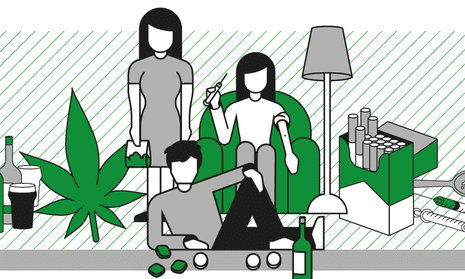Usage
More than 15 million Britons, nearly one in three of the adult population, have taken illegal drugs and the proportion of the nation who have ever taken drugs is increasing over time; when the Observer last conducted research into national drug usage and attitudes in 2008, 27% of the population had taken illegal drugs. That figure has now increased to 31%. Last time round we noted that, while men were more likely than women to take drugs, the gender gap appeared to be closing, based on a comparison between 2008 and 2002 data. That process is now complete, with both sexes equally likely to have taken drugs. Thirty-one per cent of those currently aged 16-24 have taken drugs but 35- 44-year-olds have been the biggest users of drugs with nearly half (47%) of this age group having taken them. Regionally, rates of drug taking peak in Scotland, where 35% have taken drugs.
Among those who have ever taken drugs, it is a minority (21%) who continue to do so, approximately 3 million people. The profile of those currently taking drugs is weighted towards younger Britons, with half of active users aged 16-34. In contrast to the stereotype of the drug user, many active drug takers are in the higher echelons of society, with 40% being in social grades AB.
Drug taking is widespread and on the rise but, for the majority, it does not constitute a problem; 87% of those who have taken drugs do not believe they have ever had a problem with them. However, 13% of drug users believe they have had a problem, the equivalent of approximately 2 million people. Nearly half of those have subsequently managed to break the habit and no longer use, but there are approximately 1 million Britons who have had a problem with drugs (31% of current users) and still use them. Male drug users are twice as likely as women to develop a problem at some stage (18% and 9% respectively). While drug taking is most common in Scotland, it is users in London and the south-east who are most likely to develop a problem (21%). Younger users are also more likely to believe they have had a problem; 15% of 16-24s and 25% of 25-34s.
Approximately 750,000 Britons (23% of active drug takers) take drugs every day. However, the majority of active drug users (55%) are infrequent users, taking them at an average frequency of less than once a month. Despite this relatively low frequency of use suggesting that consumption is linked to special occasions, drug taking is actually more likely to be associated with the home environment than a big night out; 84% of current drug users say they are more likely to take drugs at home or in a friend’s home, while only 16% say they are more likely to take them in a club/pub/bar environment. Young drug users aged 16-24 are the most likely to take drugs in an out-of-home, social environment (38%) but even among this group, drugs are more likely to be consumed at home. While both sexes are more likely to consume at home, women (25%) are four times more likely than men (6%) to take drugs in an out-of-home environment.
Since 2008, the proportion more likely to use drugs in a pub/club/bar environment has declined significantly, from 35% to 16%. The reasons for this are not immediately clear. The ban on smoking in pubs, clubs and bars may have reduced the opportunity to surreptitiously smoke marijuana in public places, but this was introduced in 2007, a year before our previous survey. Was there a behavioural lag following the introduction of these new laws, or has the introduction of the smoking ban kick-started a wider societal shift?
Drug users have their first experience of illegal drugs aged 19, on average. They then continue to dabble for an average of seven years before giving up at the age of 26. The results of the poll suggest that the earlier the age at which drug experimentation starts, the longer the relationship with drugs; those who still take drugs had their first experience at a younger age (16 on average) than those who have tried them but subsequently given up (20). Women tend to move through their drug phase quicker than men; while both sexes start using drugs at an average age of 19, women quit a year earlier than men, on average.
Marijuana is, by far, the most popular illegal drug among Britons; 93% of drug users (more than 14 million people) have used marijuana. It is often depicted as a gateway drug, and it is certainly true that it is the drug that most drug users use first; marijuana was the first illegal drug used by 82% of drug users. However, there is no clear evidence from this research to suggest that usage of marijuana necessarily leads to usage of other, harder, drugs. Indeed, half of marijuana users have never taken any other drug.
The proportion of drug users who have used marijuana has increased since 2008, when 87% had used it. There has also been an increase in the number who have taken cheap amphetamines such as speed, which is now the second most widely used drug (31% had taken it in 2008, 34% in 2014). Cocaine is the third most widely used illegal drug (29% of British drug users have ever used it) followed by ecstasy (25%).
The average drug user has tried just under 2.5 different illegal drugs, with men trying a greater number than women. In particular, men are significantly more likely than women to have tried hallucinogens such as LSD and magic mushrooms, as well as harder drugs such as crack.
Curiosity is the most common reason for starting to take drugs. More than two out of three who have taken drugs cite curiosity as the primary reason for starting. Wanting to fit in with friends and peer pressure are also important factors, with one in four attributing their usage of drugs to one or the other. There is an interesting gender distinction with men more likely than women to succumb to peer pressure (13% and 8% respectively), while women are more likely than men to take drugs in order to fit in with their friends (16% and 11% respectively). It is possible that the willingness to fit in with friends is a more important factor than these results would suggest, as older drug takers are more willing to admit that this was the spur to their usage. It is also true that those who no longer take drugs are far more likely to admit that they wanted to fit in with friends than those who continue to take them (17% and 4% respectively).
In total, 13% of Britons would consider taking drugs in the future. This figure includes both current users and those who have taken them in the past, a majority of whom (65%) are unwilling to do so again. However, 4% of Britons who have never previously tried drugs would consider doing so in future. If drugs were decriminalised that consideration figure would increase fourfold (to 16%), demonstrating the deterrent effect of their current legal status, particularly among younger people; 30% of 16-24s who have never previously taken drugs would at least consider doing so if they were decriminalised. Any change to the legal status of drugs would also potentially drive usage rates among those at the top of the social hierarchy, who possibly have too much to lose to risk being caught taking drugs at present; 47% of non-users in social grade A would consider taking drugs if they were decriminalised.
Unsurprisingly, marijuana is the drug that people are most likely to consider taking in the future (81% of considerers would do so) followed by cocaine (28%), ecstasy (28%), magic mushrooms (22%) and speed (20%).
Buying & selling drugs
The vast majority of drug users buy their drugs from people they know; only one in 10 buys drugs from strangers. In most cases (65%) the user doesn’t have any direct contact with the dealer, leaving the transaction to a friend who buys on their behalf. Women are particularly keen to avoid direct contact with a dealer, with 73% asking friends to buy them instead (compared with 57% of male drug users).
An even more impersonal way of buying drugs is via anonymous online marketplaces such as Silk Road. Despite a clear desire for impersonal transactions, only 2% of those who have ever taken drugs have bought from the internet. However, among those who currently take drugs this figure jumps to 16%, suggesting it is becoming a more common method of acquiring drugs. These internet purchases may be purely for personal use, but our data suggests that a significant proportion are for resale purposes; 45% of those who have sold drugs for profit have purchased drugs from the internet. Rates of internet usage for the purpose of procuring illegal drugs peaks in the 25-34 age group (8%) and those living in the south-east or London (6%).
One in 10 drug users has sold drugs in order to make a profit. However, as we have seen, most people do not buy their drugs from a dealer, but from friends who purchase on their behalf. Therefore, it’s unsurprising that more than double that number (21%) have supplied them to friends without making any profit from the transaction. At present, the law does not differentiate between those who supply drugs for profit and those who supply to friends without profiting. However, a significant minority of Britons (39%) believe that the law should make a distinction and the number supporting this legal distinction has increased, from 30%, in 2008.
Perhaps unsurprisingly, attitudes diverge based on drug consumption history: among those who have ever taken drugs (many of whom will have taken advantage of friends purchasing on their behalf) 62% believe the law should make a distinction between drug suppliers. Among those who have never taken drugs, this number falls to 29%. The vast majority (86%) of those who have supplied drugs to friends without making a profit believe the law should differentiate, although it is interesting to speculate on the reasoning of the 14% within this group who feel the law should treat all drug dealers the same. Those who advocate blanket treatment of drug dealers may want to consider that it is young Britons who are most likely to have supplied drugs to friends for no profit; 16% of all Britons aged 25-34 say they have done so.
Expenditure
The average British adult spends £32.05 per month on alcohol, £18.19 per month on tobacco products and £8.24 per month on illegal drugs. However, these figures are based on all adults, irrespective of whether they drink, smoke or take drugs. If we remove those who spend nothing on each of the categories in an average month, the figures change significantly. The average smoker spends £76.73 on tobacco and the average drinker spends £54.58 per month on alcohol. In terms of active drug users, 39% say they do not spend anything on drugs in an average month, which helps to reduce the overall monthly expenditure of this group to £45.31. If we just consider those drug users who do spend money on drugs in an average month, average expenditure increases to £74.36. In addition to the money they spend on drugs, active drug users also spend significantly more than the national average on alcohol (£66.62 per month) and tobacco products (£53.68 per month).
Men spend more than women on each of the three categories and the 25-34 age group are also the highest spenders in each category. Perhaps it’s simply a function of higher prices in the capital, but those living in London and the south-east are also the highest spenders in each of the three categories.
Legality
Britons are generally unconvinced about the prospect of the “war on drugs” ever being fought to a successful conclusion; it is only 16% who believe it can be won. Those who have first-hand experience of drugs are even more doubtful, with only 12% predicting a successful outcome of the “war on drugs”. Possibly as a direct result of this pessimism we have seen a sharp rise in the proportion of Britons who believe that certain drugs should either be legalised or decriminalised (27% in 2008, 39% in 2014). Men (45%) are more likely than women (34%) to feel that some drugs should be legalised or decriminalised, and almost half of Britons aged 25-34 (48%) and 35-44 (46%) advocate legalisation. Among those who used to take drugs, but no longer do, 57% support some legalisation/decriminalisation, and among those who currently take drugs, this figure increases to 86%.
The vast majority of those advocating a change to the legal status of drugs do not advocate a blanket treatment of all drugs; only 3% believe that all of them should be either legalised or decriminalised. Indeed, for many people the issue appears to be primarily focused on the legality of marijuana, which 88% of those advocating change believe should be legalised or decriminalised. In total, 52% of all Britons believe we should follow the example of Colorado and Washington and legalise the sale and possession of marijuana for both medical and non-medical use. Those aged 25-34 are most likely to support this (60%) but it is significant that 45% of those aged 65 or older (who tend to be the most conservative in their attitudes to drugs-related issues) concur. It is also interesting that 43% of people who have never taken drugs believe marijuana should be legalised (this rises to 73% among drug users). Support for a change in law peaks in London and the south-east (57%) and men are more likely than women to support change (58% and 45% respectively).
Strong support for a change in the legal status of marijuana seems to be linked to a perception that it poses relatively little harm to the health of the user. Asked to rate a selection of both legal and illegal drugs based on the health risk they pose, our survey placed marijuana at the very bottom of the risk hierarchy, below both alcohol and tobacco. Britons aged 35-44 are most likely to consider marijuana relatively benign, but this view is shared across the age spectrum. The drugs that Britons believe pose the greatest health risks are hard drugs such as heroin and crack, and it appears that most make a clear distinction between marijuana and drugs of this type.
Despite widespread support for a change in legal status for marijuana, it is still a minority (27%) who feel that the drug laws in this country are not liberal enough. However, this figure has increased, from 18% in 2008, and the proportion who feel the drug laws are too liberal has decreased over the same period (32% in 2008, 27% in 2014). We expect that attitudes towards this issue will continue to shift as attitudes correlate directly with age; among the youngest (16-24) only 14% believe the laws are too liberal, while 33% say they are not liberal enough. In contrast, among the oldest (65+) 40% believe the current drug laws are too liberal and only 19% not liberal enough. The results for this question also provide more evidence that men tend to be more liberal in their attitudes to drugs than women.
Nearly half of Britons (47%) would support a scheme whereby certain illegal drugs were available on prescription to registered drug addicts. Support for a scheme of this type has increased slightly, from 44% in 2008, with levels of support highest in London and the south-east, where more than half (53%) of the population would support the scheme.
Support may be related to the belief that a high level of street crime is either directly or indirectly linked to drugs and that decriminalisation of hard drugs would lead to a reduction in street crime. Britons estimate that 50% of all street crime is linked to drugs, with the estimate peaking in the north (54%). There is a direct correlation with social grade in that those in the lower social grades attribute a much higher proportion of street crime to drugs than those who are higher up the social ladder.
We have actually recorded a consistent drop in estimates of the link between drugs and street crime (66% in 2002, 56% in 2008 and 50% in 2014) but the link between drugs and crime is clearly established and 46% of Britons feel that levels of street crime would reduce if hard drugs were decriminalised (up slightly from 44% in 2008). Those who currently take drugs are most likely to feel that decriminalisation would reduce street crime (72% do so) but 43% of those who have never taken drugs agree. Britons aged 16-24 are most likely to believe that street crime would reduce if hard drugs were decriminalised (64%).
Despite the high levels of crime associated with drugs, the vast majority (95%) of drug users have never committed a criminal act in order to fund their purchase of drugs. That is a reflection of the fact that most drug users do not believe they have ever had a problem with drugs, and those who commit criminal acts to fund drug purchases invariably have a problem: among those who admit to a drug problem, 67% say they have committed criminal acts to feed their habit. Men are more likely to develop drug problems, and they are also more likely to commit crime to feed their habit (9% of male drug users have done so compared with 1% of female drug users). Drug users in London and the south-east are most likely to have resorted to crime to fund drug purchases (10% have done so).
Legal highs
One in 10 Britons has taken legal highs, ie drugs not currently covered by misuse of drugs laws (also known as new psychoactive substances (NPS). Usage of legal highs is most common among young Britons; 16% of 16-24s and 19% of 25-34s have taken them. Regionally, use is highest in London and the south-east, where 16% have taken them. While legal highs are most likely to be taken by people who also take illegal drugs (44% of current drug users have taken legal highs), 4% of those who have never taken an illegal drug have taken legal highs.
The NHS Choices website warns that, despite their current legal status, “legal highs can carry serious health risks”. While this message has clearly been absorbed by the majority of those who take them (72% of this group believe legal highs are more dangerous or pose the same level of danger as illegal drugs) there are still 29% of legal high users who believe they are less hazardous to health than illegal drugs. The youngest users of legal highs (ie 16-24s) are twice as likely to believe they are less harmful than illegal drugs (30%) than believe they are more harmful than illegal drugs (15%).
Usage of synthetic drugs such as spice, which mimic the effects of cannabis and are often sold as natural highs, is lower than usage of legal highs; only 4% have tried synthetic drugs. Of those who currently take illegal drugs, 18% have tried synthetic drugs. Usage is greatest in London and the south-east (8%) and among 16-34s (9%).
Nearly half of all Britons (49%) consider themselves either “very” or “quite” knowledgeable about drugs. Knowledge levels correlate directly with age, with the youngest most likely to consider themselves knowledgeable (71% of 16-24s are “very” or “quite” knowledgeable) and each successive age group gradually less likely to consider itself knowledgeable.
Predictably, knowledge also correlates with usage; 88% of current users are knowledgeable and while knowledge levels are significantly lower among non-users (42%) they remain fairly high. One reason for these high knowledge levels among non-users is because many of us have known someone we believe has a serious problem with drugs; 38% of Britons do so, up from 32% in 2008.
Only 13% of those who have taken drugs themselves believe they have had a problem. Among those who have had a problem themselves, 89% know others in the same situation. Scotland is the region where the highest proportion (50%) currently know someone, or have known someone, with a serious drug problem and it also happens to be the region where drug knowledge levels are highest (68% consider themselves knowledgeable).
Children & drugs
Do you have a child aged between 12 and 35 years?
Yes = 37%
No = 63%
Among those who participated in our poll, 37% have children aged between 12 and 35 years old. In a sign that parenthood does not necessarily curtail drug usage, 39% of current drug users have a child in that age range.
Among parents there is a high level of realism regarding the drug usage of their children; just under one in five (19%) are certain that their children have taken drugs, while a further 27% concede that they probably have. In total, 46% of parents of children aged 12 to 35 say their children have either certainly or probably taken drugs.
Mothers are more likely than fathers to say their children have certainly taken drugs (23% and 16% respectively) and parents in London and the south-east are most likely to say their children have either certainly or probably taken drugs (56% in total). Parents who have taken drugs themselves are more likely than those who haven’t to say their children have certainly tried them (34% and 12% respectively). Parents who are currently married are less likely to believe their children have taken drugs (61% don’t believe they have) than parents who are divorced (45%) or single (41%).
Among those parents who do not currently know or suspect that their children have previously taken illegal drugs, only 4% believe their children would be likely to take drugs in future.
Prescription drugs
Usage of prescription drugs for recreational purposes is not common, but is growing in popularity. In 2008, 4% of Britons said they had used prescription drugs recreationally. That figure has now increased to 6% and is particularly prevalent in the south-west and Wales (9%) and London and the south-east (9%). Prescription drugs are particularly popular among higher social grades; 20% of the social grade A group have taken prescription drugs recreationally.
One in three of those who currently take illegal drugs has taken prescription drugs to get high, but the practice is not limited to users of illegal drugs; 3% of Britons who have never taken illegal drugs have used prescription drugs recreationally. The most popular prescription drugs, when used recreationally by those we spoke to, include Valium, temazepam, diazepam, Co-codamol and tramadol.
Nearly one in four people (23%) have suffered side-effects or withdrawal symptoms from drugs prescribed to them by their doctor, and a significant minority (30%) do not believe that drugs prescribed by their doctor have been fully investigated for possible side-effects.
Key workers
There are high levels of public support for the routine drug testing of a wide variety of key worker groups. Support for routine testing is highest for groups whose ability to perform to the optimum has a very direct impact on our safety, such as pilots, train driver, police, and doctors/nurses.
The same direct link between performance and public safety is not true of other key worker groups and support for testing is consequently lower. However, as a clear indication that we feel these groups should be held to the highest possible standard, a large proportion also support the introduction of routine drug testing for teachers (61%), politicians (55%) and lawyers (45%). Generally women are more likely than men to believe each of these key workers should undergo drugs tests. Support for routine drug testing also increases with age.
Sex & drugs
Nine per cent of the population have, at some point, taken drugs in order to improve their sex life. There is no clear evidence that the drugs they have taken for this are illegal, as opposed to legally available drugs such as Viagra. However, it is noticeable that illegal drug users are significantly more likely than those who have never taken illegal drugs to have used some form of drug in order to improve their sex life (16% and 6% respectively).
Men (15%) are significantly more likely than women (4%) to have taken drugs to improve their sex life. In terms of age, the 25-34 age group is most likely to do so (14%) followed by the 65+ age group (10%). It may be reasonable to assume that the older group are more likely to be using legally available drugs for this purpose.
Methodology
A sample of 1,080 UK adults was interviewed by Opinium Research between 8 and 14 July 2014 via an online questionnaire, ensuring absolute anonymity. Interviews were conducted with respondents across the country and the results have been weighted to reflect the profile of all UK adults. Not all percentages add up to 100 due to rounding.










Comments (…)
Sign in or create your Guardian account to join the discussion